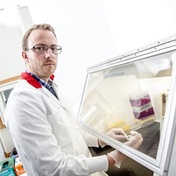US scientists said they have taken an important step toward making an artificial life form by making a ribosome - the cell's factory.
The ribosome makes the proteins that carry out key business for all forms of life. Messenger RNA carries DNA's genetic instructions to a cell's ribosome, which then cooks up the desired protein. Every living organism from bacteria to humans uses a ribosome, and they are all strikingly similar.
It is not quite artificial life, but an important step in that direction, said George Church, a professor of genetics at Harvard Medical School, who directed the research with a single graduate student.
Need machine to make life
"If you going to make synthetic life that is anything like current life ... you have got to have this ... biological machine," Church told reporters in a telephone briefing.
And it can have important industrial uses, especially for manufacturing drugs and proteins not found in nature.
Church stressed his research has not been published in a scientific journal, the usual route for reporting such work. He presented it over the weekend to a seminar of Harvard alumni.
Designer proteins
Church's group is not seeking to make life in a test tube, but instead to make designer proteins in lab dishes.
"We can ... go straight into protein synthesis," he said. Church and post-doctoral fellow Mike Jewett have already synthesised firefly luciferase - the glowing stuff.
"We'd also like to make a whole new kind of cell ... which is a mirror image of a replicating system." Most life forms are "right-handed" or "left-handed," a quality called chirality.
Changing chirality is known to change the effects of drugs in the body. For instance, thalidomide, once used to prevent morning sickness, causes severe birth defects. It has left- and right-handed versions and only the "left" version caused the defects - but the marketed drug contained both types.
Can be used to make drugs
It may be possible to make other proteins in a lab dish without using living cells, Church said. These may include drugs that have been too hard to make now using a process called rational drug design, when drugs are built molecule by molecule to have a specific mechanism of action.
Viruses do not count as living organisms by most definitions, Church said, and to build the simplest form of artificial, but true life it would take 151 genes, he and other experts calculate.
"One hundred fifty one genes would include enough genes to replicate DNA, produce RNA, produce ribosomes and have a very primitive membrane," Church said.
Genome pioneer Craig Venter is trying to make artificial life, using a company called Synthetic Genomics Inc. They are working on projects including synthetic vegetable oil that could be used as clean-burning biofuel. – (Maggie Fox/Reuters Health, March 2009)
Read more:
Artificial life breakthrough




 Publications
Publications
 Partners
Partners














